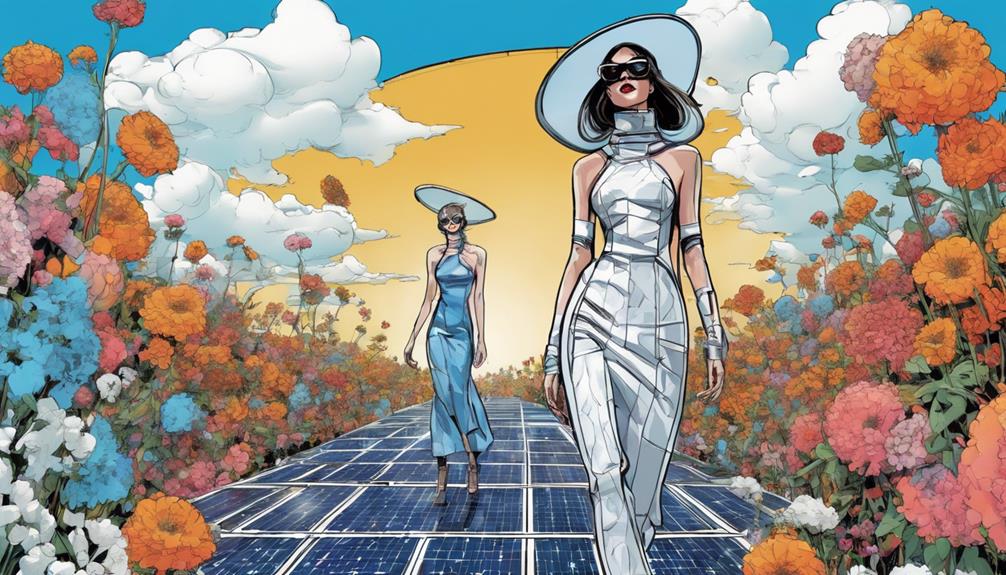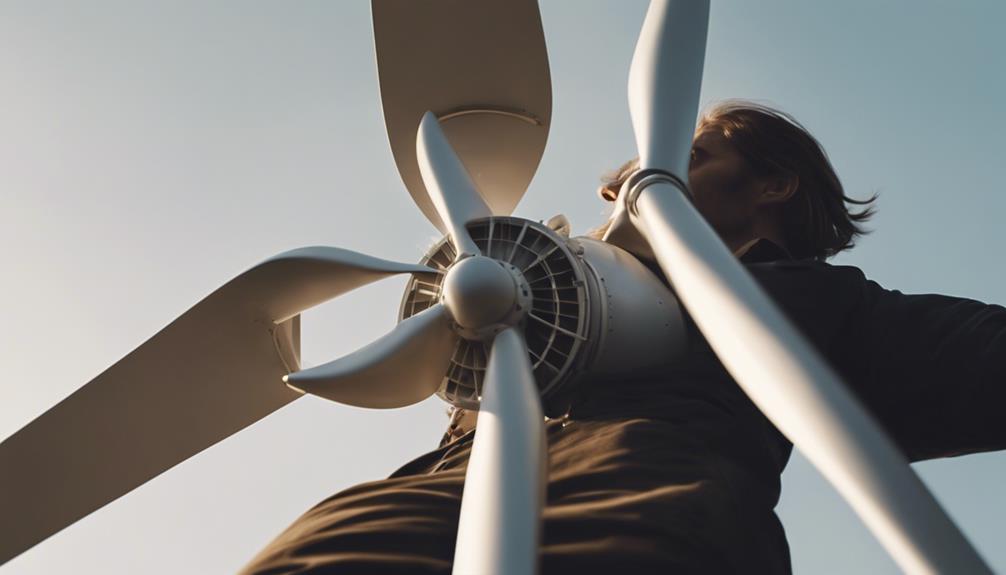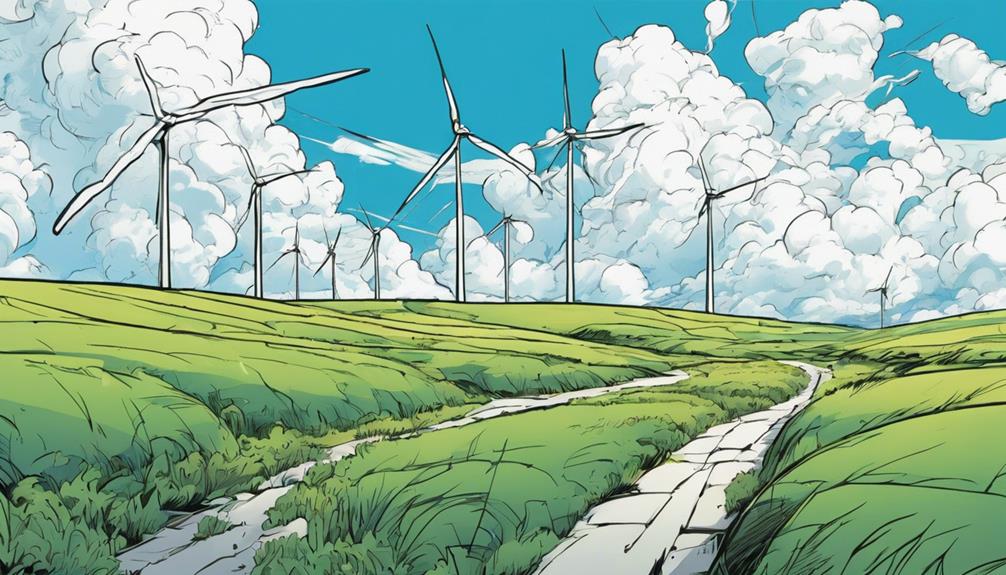When utilizing wind turbine energy, you'll need to address infrastructure challenges like size constraints in components and regulatory compliance for transportation. Coordinating logistics for moving components and handling installation complexities are key. Consider the turbine tower heights for maximizing energy potential and efficiency. Manufacturing and transportation pose challenges due to blade size and innovative transportation solutions. To grasp the full list of infrastructure requirements and further insights, explore the intricacies of visual impact considerations, mitigation recommendations, installation logistics, and community engagement. Understanding these aspects will help you successfully harness wind turbine energy.
Key Takeaways
- Turbine components must navigate size constraints.
- Logistics coordination is essential for component movement.
- Compliance with transportation regulations is crucial.
- Installation logistics present complexities.
- Future solutions are sought for turbine transportation.
Visual Impact Considerations
Considering the visual impact of wind turbines is essential when planning for wind energy projects. Visual impact assessments play an important role in evaluating the effects of these structures on landscapes.
Wind turbines, towering between 250 to 540 feet in height, can create significant visual intrusions in natural scenery. Organizations like Scenic America emphasize landscape mitigation strategies to address these visual impacts effectively. Recommendations include utilizing white or neutral-colored turbines, arranging them in smaller groupings, and avoiding visible roads and clearings to minimize their visual prominence.
Mandatory visual impact assessments for wind energy construction projects are essential to assess the potential impacts on scenic, cultural, and historic attributes of the landscape. Community considerations also play a key role in mitigating visual impacts, focusing on understanding project scope, complying with regulations, and strategically locating turbines to minimize their visibility from residential areas and transmission lines.
Recommendations for Mitigation
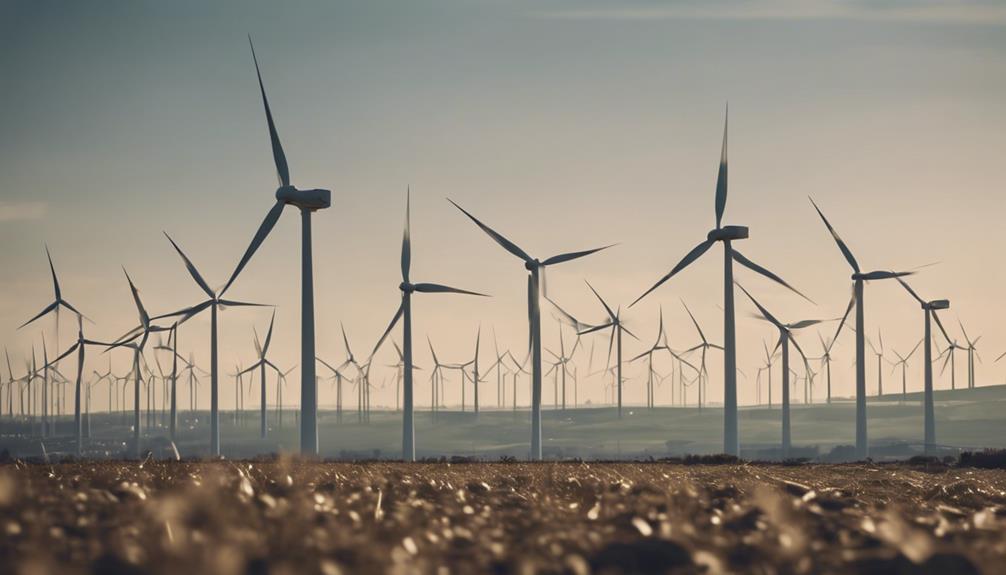
To mitigate visual impacts effectively in wind energy projects, it's recommended to utilize white or neutral-colored turbines and arrange them in smaller groupings. By opting for columnar turbines in these hues, the visual intrusion on landscapes can be minimized.
Additionally, avoiding visible roads and clearings around turbines is essential to preserving the natural appearance of the surroundings. Shielding substations and support structures from view is equally significant in the visual mitigation process.
Conducting visual impact assessments should be a mandatory step in wind energy projects to evaluate and address potential aesthetic concerns proactively. These assessments help in identifying areas where visual impacts can be mitigated effectively, ensuring that the wind turbines blend harmoniously with the environment.
Questions for Construction
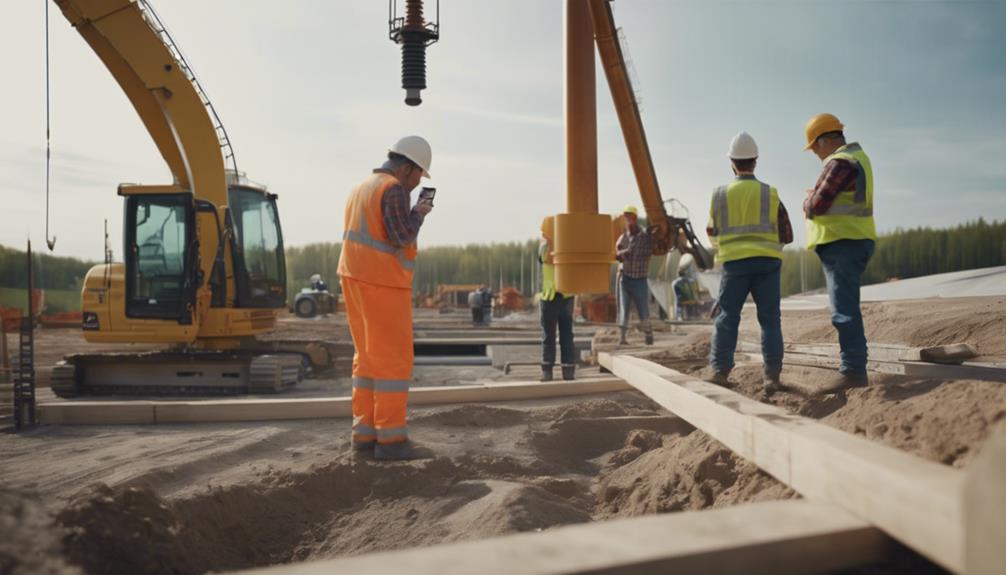
Construction planning for wind energy projects must carefully address landscape alterations, local plan conflicts, and potential visual impacts to guarantee successful implementation.
When considering the construction phase of a wind energy project, questions surrounding the installation of wind turbine towers are paramount. The height and placement of these towers can greatly impact the visual landscape and must align with local regulations and visual impact assessment findings.
Key questions for construction include determining the best locations for wind turbine towers to maximize energy production while minimizing visual obtrusiveness. Additionally, considerations regarding the distance between towers, their orientation, and the use of shielding structures to mitigate visual impacts are vital.
Ensuring that the construction of wind turbine towers adheres to visual impact assessment recommendations is essential for community acceptance and project success. By addressing these questions during the construction planning phase, wind energy projects can effectively balance energy production goals with visual harmony in the surrounding landscape.
Visual Impact Assessment Process

You need to understand how inventorying and mapping visual resources, creating photo simulations, and rating landscape attributes play an important role in evaluating the visual impact of wind turbines.
These methods provide valuable insights into the potential effects of wind energy infrastructure on scenic, cultural, and historic landscapes.
Inventory and Mapping
One important step in evaluating the visual impact of wind turbine energy projects is conducting an inventory and mapping process to assess the landscape's scenic attributes. During this stage, visual resources are inventoried, and viewsheds are mapped to determine how wind energy projects might impact the visual appeal of the area.
This process involves rating the scenic, cultural, and historic attributes of the landscape to understand how the installation of wind turbines could affect the surroundings. By considering various vantage points, the assessment aims to provide a thorough understanding of how the project will visually impact different areas within the landscape.
The findings from this visual impact assessment are then compared with the benefits that the wind energy project would bring to determine the overall impact on the environment and the community. Photo simulations and computer models are often used in conjunction with the inventorying and mapping process to visualize the potential visual changes that would result from the installation of wind turbines.
Photo Simulations
During the evaluation of wind turbine energy projects, an integral aspect involves utilizing photo simulations in the visual impact assessment process to understand how the turbines will visually blend within the landscape.
These simulations play a pivotal role in appraising the visual impact of wind turbines on the surrounding environment. By creating visual representations based on computer models, stakeholders gain valuable insights into how the turbines will appear in the landscape.
This process helps in evaluating and mitigating the aesthetic effects of wind energy infrastructure. Photo simulations are essential for stakeholders to visualize the potential visual impact of wind turbine projects and make informed decisions regarding their placement and design.
Through these simulations, the project developers and communities can collaborate to find solutions that minimize the visual impact while maximizing the benefits of wind energy production.
Landscape Attribute Rating
Considering the scenic, cultural, and historic attributes of the landscape is crucial in the visual impact evaluation process for wind energy projects. Visual impact evaluations involve analyzing these landscape attributes to understand how a wind energy project might affect the surroundings. This process includes inventorying visual resources, mapping viewsheds, and creating photo simulations to predict the project's visual impact accurately.
By evaluating impacts from various vantage points, developers can gain a thorough understanding of the potential visual intrusions that may arise. The findings from the visual impact evaluation are then carefully compared with the benefits that the wind energy project offers. By aligning these evaluations with the project benefits, developers can identify ways to mitigate any negative visual impacts effectively.
Ultimately, the goal of the visual impact evaluation process is to strike a balance between preserving the landscape's attributes and reaping the benefits of sustainable wind energy generation.
Community Considerations

When evaluating wind energy projects, the community's involvement and needs must be carefully considered. Here are three key community considerations for wind energy developments:
- Engagement:
Community engagement is vital for successful wind energy projects. Guaranteeing that residents are informed about the project, addressing their concerns, and involving them in the decision-making process can help build support and mitigate opposition.
- Environmental Impact:
Communities are rightfully concerned about the environmental impact of wind energy projects. Compliance with environmental regulations, minimizing habitat disruption, and conducting thorough environmental assessments are essential to address these concerns.
- Social Benefits:
Wind energy projects can bring various social benefits to communities, such as job creation, economic development, and increased tax revenue. It's important to highlight these positive impacts to garner community support and secure the project's long-term success.
Infrastructure Challenges

You face significant challenges in wind energy infrastructure due to the complexity of the infrastructure, installation logistics, and maintenance facilities required.
The size and dimensions of turbine components pose obstacles in transportation and logistics, impacting the industry's development.
Addressing these challenges is essential for accommodating future giant turbines and advancing innovation in the wind energy sector.
Infrastructure Complexity
Managing the infrastructure complexity in the wind energy sector poses significant challenges, particularly in the delivery and installation of large turbine components. The transportation of these massive components requires careful planning and execution due to their size and weight.
Here are three key aspects contributing to the infrastructure complexity in the wind energy sector:
- Size Constraints: The sheer size and dimensions of wind turbine components, such as blades and tower sections, present challenges for transportation. Specialized vehicles and equipment are necessary to move these oversized parts from manufacturing facilities to wind farm sites efficiently.
- Logistics Coordination: Coordinating the movement of various components from different suppliers to the wind farm site can be a logistical puzzle. Ensuring timely delivery and synchronizing the arrival of components is vital to avoid delays in the installation process.
- Regulatory Compliance: Meeting transportation regulations, especially regarding oversized loads, adds another layer of complexity. Securing permits, adhering to weight restrictions, and following specific routes are essential to guarantee safe and compliant transportation of wind turbine components.
Installation Logistics
Addressing the installation logistics for wind turbine components involves overcoming significant infrastructure challenges related to their size and weight. The logistical challenges arise primarily due to the sheer scale of the components, making transportation and installation complex tasks.
The width and dimensions of wind turbine towers pose constraints on transportation, requiring careful planning and coordination. Tower height is another pivotal factor, influencing the transportation process and necessitating specialized equipment for safe and efficient installation.
Innovative projects are actively seeking solutions to enhance the transportation efficiency of future giant turbines. Streamlining the logistics of delivering and installing wind turbine components is essential for the successful operation of wind energy infrastructure.
Maintenance Facilities
One significant aspect of wind turbine infrastructure is the establishment of efficient maintenance facilities. These facilities play a pivotal role in guaranteeing the smooth operation and longevity of wind turbines.
Here are three key points to ponder regarding maintenance facilities in wind energy infrastructure:
- Equipment and Spare Parts Storage:
Maintenance facilities are essential for housing spare parts and equipment necessary for the upkeep of wind turbines. Having these resources readily available can minimize downtime and ensure prompt repairs when needed.
- Safety and Functionality:
Properly designed maintenance buildings ensure the safety and functionality of electrical equipment within wind farms. This is essential for the overall reliability and performance of the turbines.
- Location and Accessibility:
The location of maintenance facilities is a crucial factor for the efficient operation and maintenance of wind turbines. Adequate space and accessibility are vital considerations when planning and constructing maintenance buildings to support the ongoing maintenance schedules and activities of the wind farm.
Turbine Tower Heights

Utilizing taller wind turbine towers is vital for maximizing wind energy potential and increasing electricity generation efficiency. Taller turbines enable harnessing stronger winds at greater heights, critical for unleashing the full electricity production capacity in regions with varying wind conditions. Technological advancements continue to push the boundaries of wind turbine tower heights, paving the way for broader wind energy deployment across the U.S. These innovative projects not only focus on increasing tower heights but also address transportation challenges associated with the installation of these tall structures.
Accessing stronger winds with taller turbines greatly enhances both the efficiency and cost-effectiveness of wind energy production. By reaching higher altitudes, wind turbines can capitalize on more consistent and powerful winds, boosting overall energy output. Embracing taller turbine towers is a strategic move towards optimizing wind energy resources and meeting the increasing electricity demands sustainably.
Manufacturing and Transportation Challenges

Manufacturing and transporting long turbine blades presents substantial complexities due to their size and rigidity, posing challenges for the wind energy industry.
When considering transportation constraints, several key points arise:
- Size and Stiffness: The sheer length and lack of flexibility in turbine blades make their transportation arduous. Traditional transportation methods struggle to accommodate these large and unwieldy components efficiently.
- Extended Routes: In some cases, elongated transportation routes must be taken to circumvent roadblocks or restrictions that can't accommodate the size of the turbine blades. This can markedly increase transportation time and costs.
- Innovative Solutions: To tackle these challenges, the industry is exploring innovative solutions such as developing flexible blades that can be more easily transported. These advancements aim to streamline the transportation process and make it more feasible for large-scale wind energy projects.
Addressing manufacturing and transportation challenges is vital for the wind energy sector to overcome current limitations and support the continued growth of renewable energy infrastructure.
Frequently Asked Questions
What Are the Infrastructure Requirements for Utilizing Wind Energy?
When utilizing wind energy, you need a range of infrastructure like wind turbines, electrical grids, substations, and support structures. Specialized transportation and maintenance are vital. Proper planning guarantees efficient operation and integration with the electrical grid.
What Are the Site Requirements for Wind Turbines?
When setting up wind turbines, you need sites with consistent strong winds like coastal areas or mountain ridges. Proper spacing between turbines is essential for efficiency. Evaluating wind speeds and environmental impacts guarantees ideal turbine placement.
What Is the Infrastructure of a Windmill?
To power a wind turbine, infrastructure includes blades, a tower, and a nacelle housing the generator. The tower supports the blades at an ideal height, and the nacelle contains the gearbox, generator, and control electronics.
What Are the Wind Requirements for a Wind Turbine?
To maximize energy production, wind turbines need wind speeds of 25-30 mph. They can withstand high speeds up to 55-75 mph for safety. Turbines adjust to wind changes, capturing energy from different directions.
How Does Government Ownership Affect Wind Turbine Infrastructure Requirements?
Governmentowned windmills can impact the infrastructure requirements for wind turbines. With government ownership, there may be more resources available for investment in larger and more advanced wind turbine technology. Additionally, government regulations and policies may influence the location and expansion of wind turbine infrastructure.
Conclusion
To sum up, have you considered the infrastructure challenges and visual impact of utilizing wind turbine energy?
With proper planning and mitigation strategies in place, communities can harness the power of wind while minimizing negative effects.
Are you ready to embrace sustainable energy solutions for a brighter future?




